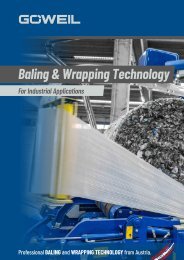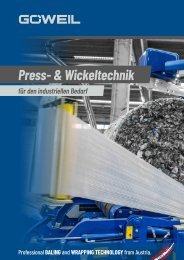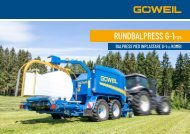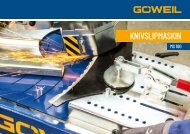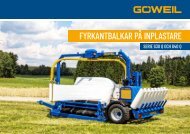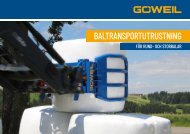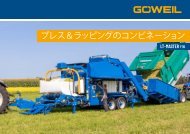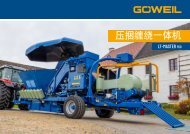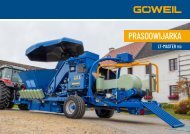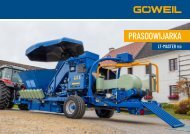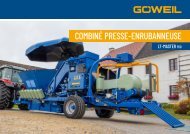Farm Machinery Journal - G-1F125 Kombi
The Farm Machinery Journal from England, pays a visit to one of our customers and talks to them about their GÖWEIL G-1 F125 Combi
The Farm Machinery Journal from England, pays a visit to one of our customers and talks to them about their GÖWEIL G-1 F125 Combi
Create successful ePaper yourself
Turn your PDF publications into a flip-book with our unique Google optimized e-Paper software.
Left: A monitor<br />
and two cameras<br />
are standard on<br />
the Göweil baler<br />
Right: The Göweil<br />
features plastic bands<br />
and six rows of tines,<br />
so should give a clean<br />
and quiet sweep<br />
Left: The G-1 is<br />
ISObus controlled<br />
and a stand-alone<br />
screen is available<br />
if your tractor is<br />
not compatible<br />
Right: Two crop<br />
press rollers and a<br />
hydraulically driven<br />
feed roller give a good<br />
feed with little room<br />
for bridging<br />
The knives are below the binding<br />
system and can be changed without<br />
tools or opening the chamber, or<br />
crawling around underneath. The<br />
knives are reversible and give a<br />
35mm theoretical chop length.<br />
Richard gives those on his baler a<br />
touch-up every 1000 bales so they<br />
don’t dull easily. The crop flow would<br />
see the knives working in the top of<br />
the swath, as it’s lifted by the pick-up<br />
rather than the bottom, so soil or<br />
stone contamination may play a<br />
factor in how long the edge lasts.<br />
Before the rotor is the 2.2m header,<br />
which looks well engineered and has<br />
a pendulum action to follow the<br />
ground. This allows each<br />
wheel to lift by 150mm<br />
without causing the<br />
opposite wheel to lift off.<br />
The jockey wheel arms<br />
wouldn’t look out of<br />
place on a plough. The<br />
roller crop press is equally<br />
well built with sealed<br />
bearings at either end of the<br />
double roller press. Behind that is<br />
a hydraulically driven feed roller and<br />
short augers to push crop in from the<br />
sides of the header. It’s all tightly<br />
arranged and Richard says the feed is<br />
good even in shorter crops, as there<br />
is little space for bridging.<br />
Above inset:<br />
Owner-operator<br />
Richard Lennie<br />
quickly dismissed<br />
more established<br />
brands in favour<br />
of another Göweil<br />
The pick-up is an area where<br />
Richard has seen great<br />
improvement. “With our old<br />
baler we did some work with<br />
Göweil on the tines. We did<br />
have some trouble with<br />
breaking tines and<br />
experimented with different<br />
angles, but we have only broken<br />
a handful on the new machine,” he<br />
says. Also Göweil adopted a plastic<br />
tine band that has worked very well.<br />
“We do have some meadowland that<br />
has some sharp undulations, and if<br />
you’re not careful it can cause the<br />
pick-up to bottom out. This would<br />
bend steel bands but the plastics just<br />
“It’ll make a good bale in<br />
pretty much any crop”<br />
WWW.FARMMACHINERYJOURNAL.CO.UK APRIL 2022




